|
This is an article about the green frog, the species of frog that lives in
my pond. It is from the web site http://www.hiltonpond.org/ThisWeek040515.html
Back in the 1980s, it was not uncommon on a midsummer's night to hear the basso
profundo of Bullfrogs thundering from the banks of Hilton Pond. "Mmmwwongg" was how they always sounded to our ears, although some folks claim these big amphibians
say "jug-o-rum." Regardless of the lyrics, the Bullfrog's song seldom breaks our nighttime silence any more, and rather than
several big males competing with ever-louder calls, we're lucky to hear even one in the course of the breeding season. We
suspect the demise of local Bullfrogs was caused in part by drought-induced loss of shallow water where their tadpoles could
develop, and undoubtedly weed-eating Grass Carp that were dumped into Hilton
Pond 15 years ago consumed so much aquatic vegetation that Bullfrogs and their young had
nowhere to hide from Largemouth Bass and other predators. Now that the water level is back up and the carp have pretty much
died out, we're hopeful both submerged plant life and our Bullfrogs will return. In the meantime, we content ourselves with
listening to and watching the antics of the Center's ever-growing population of Green Frogs--smaller cousins of the Bullfrog.
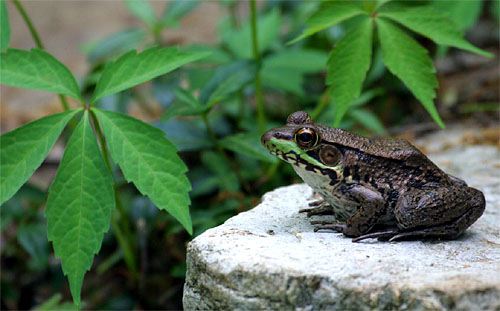
All text & photos © Hilton Pond Center
Green Frogs and Bullfrogs are similar in appearance and are often misidentified.
The genus epithet they share--Rana--is the Latin word for "frog." R. catesbeiana, the Bullfrog,
is named for early naturalist Mark Catesby, and reaches lengths of up to 6" from snout to vent. Green Frogs, R. clamitans
(meaning "loud-calling"), seldom have bodies longer than four inches. The hind legs of both species are proportionally long--usually
longer than the body itself. 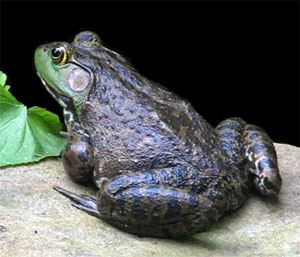 Providing leverage for these enormous jumping legs is a rigid framework composed of a winged sacral vertebra and two
attached ilial bones--a structure so well-developed it forms visible protrusions on the frog's back. Often these sacral bumps
are more pronounced in the Bullfrog, but the best way to differentiate Bullfrogs from Green Frogs is to look for a long dorsolateral
fold in the latter. This ridge of skin begins just behind the eye of the Green Frog (top photo and just below) and
extends to where the hip bones protrude; the fold is absent in Bullfrogs (above right). Other than that, the color
patterns and external anatomy of these closely related species can be very similar. Providing leverage for these enormous jumping legs is a rigid framework composed of a winged sacral vertebra and two
attached ilial bones--a structure so well-developed it forms visible protrusions on the frog's back. Often these sacral bumps
are more pronounced in the Bullfrog, but the best way to differentiate Bullfrogs from Green Frogs is to look for a long dorsolateral
fold in the latter. This ridge of skin begins just behind the eye of the Green Frog (top photo and just below) and
extends to where the hip bones protrude; the fold is absent in Bullfrogs (above right). Other than that, the color
patterns and external anatomy of these closely related species can be very similar.
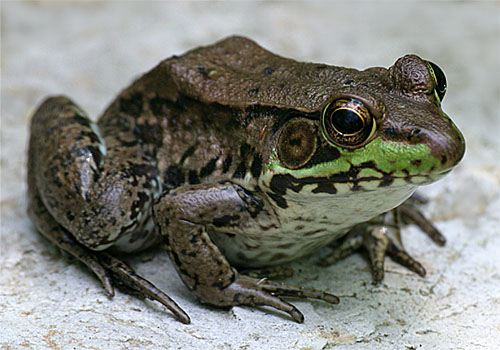
Quite commonly the Green Frog has a lime green upper lip (above), but
color on the remainder of the dorsal surface varies from dark olive brown to bright green to tan. In fact, herpetologists
recognize separate subspecies based in part on color, with Rana clamitans melanota being the Green Frog and
R. c. clamitans the tan-colored Bronze Frog, which has a more southeasterly distribution and bears no blotches
on the back. 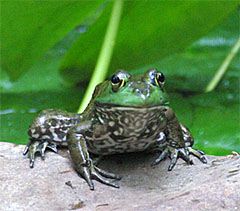 These subspecies probably interbreed where their ranges overlap, resulting in intergrade coloration and markings. Representatives
of either subspecies have white bellies with varying amounts of dark spots; some individuals have completely white chins while
in others the reticulation covers the entire ventral surface (above left). Breeding male Green Frogs are reported to
have bright yellow chins, but at Hilton Pond Center we've only seen pale yellowing along the lower lip (bottom photo). All said, Green Frogs exhibit
a tremendous amount of variation in appearance--so much so that individuals can be identified in the field. These subspecies probably interbreed where their ranges overlap, resulting in intergrade coloration and markings. Representatives
of either subspecies have white bellies with varying amounts of dark spots; some individuals have completely white chins while
in others the reticulation covers the entire ventral surface (above left). Breeding male Green Frogs are reported to
have bright yellow chins, but at Hilton Pond Center we've only seen pale yellowing along the lower lip (bottom photo). All said, Green Frogs exhibit
a tremendous amount of variation in appearance--so much so that individuals can be identified in the field.
Other than the legs, the most obvious external structures on a Green Frog are
its eyes, which are so large they're practically outside the animal's skull. The eyes are so positioned that out of the water
a frog can see in front of, beside, and directly behind itself--one reason it's so hard to sneak up on one while it sits on
the pond bank. 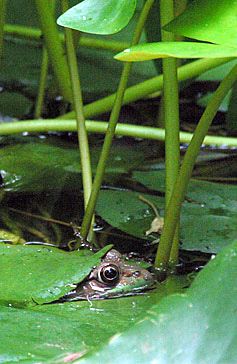 Additionally, the eyes are almost on top of the head, which allows a frog to hide nearly submerged in water with only its
eyeballs and nostrils exposed (below right). Additionally, the eyes are almost on top of the head, which allows a frog to hide nearly submerged in water with only its
eyeballs and nostrils exposed (below right).
In Green Frogs, as in Bullfrogs, there is a prominent external eardrum behind each
eye. This tympanum is equal in size to the eye in females, but noticeably larger in males. We've always found this to be curious
because in both species it is the males that call, and females that locate the most promising male by sound. (Perhaps males
need bigger ears to keep apprised of the quality and intensity of their competitors' vocalizations.) Unlike the Bullfrog's
drawn-out "mmmwwongg," the primary mating call of the Green Frog is a deep, abrupt "guungk" that some listeners liken to the
twang of the lowest string on a banjo. They make several other sounds, including a high-pitched squeek when they are startled
and leap away.
Green Frogs, which occur across the entire eastern and central U.S. and even
southern Canada, usually breed from April through mid-summer when females move toward calling males. As is often the case
in the animal world, mate choice among Green Frogs is made by the female, who probably bases her selection on quality and
size of the habitat being defended by a male. After the male mounts a receptive female, he may stay clasped to her for several
hours--even days--holding on with stout forelegs and thickened thumbs. This lengthy "amplexus" continues until the female
releases her eggs and the male fertilizes them externally. A large female Green Frog may lay as many as 7,000 jelly-covered
eggs that clump around vegetation in shallow water. 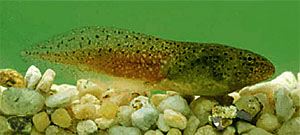 The eggs hatch within a week or so, but some resulting tadpoles may take up to 22 months to metamorphose into tailless subadults--a
sign that some future Green Frogs overwinter as fat, two-inch long tadpoles (above left). The same is true of Bullfrogs,
a sign that both species must lay their eggs in permanent bodies of water rather than temporary vernal pools used by some
salamanders and many smaller frog species. Incidentally, Green Frogs typically overwinter buried in aquatic mud, where they
breathe through their skins. The eggs hatch within a week or so, but some resulting tadpoles may take up to 22 months to metamorphose into tailless subadults--a
sign that some future Green Frogs overwinter as fat, two-inch long tadpoles (above left). The same is true of Bullfrogs,
a sign that both species must lay their eggs in permanent bodies of water rather than temporary vernal pools used by some
salamanders and many smaller frog species. Incidentally, Green Frogs typically overwinter buried in aquatic mud, where they
breathe through their skins.
Although Bullfrogs generally seek larger aquatic habitats, Green Frogs are as
just as likely in smaller permanent impoundments, where adults eat a variety of invertebrates and their tadpoles eat algae.
Just outside the office window at Hilton Pond Center we have a year-round water garden made of two connected 4' X 5' pools containing Pickerelweed and Water Lilies and
surrounded by large flat rocks. Almost any day from last frost through October we see several Green Frogs--and occasionally
a Bullfrog or two--all perched around the pools, sometimes sitting for hours without moving until an appetizing insect flies
too close. Then in a flash the Green Frog lunges forward, flips out its rear-hinged tongue, grabs the prey item, and pulls
its eyeballs into their shallow sockets to help force the insect down its throat. Having hunted successfully at Hilton Pond Center, the Green Frog returns to its perch,
where it remains motionless until the next insect appears or hormones cause it to come forth with that distinctive, twangy,
one-syllable "guungk."
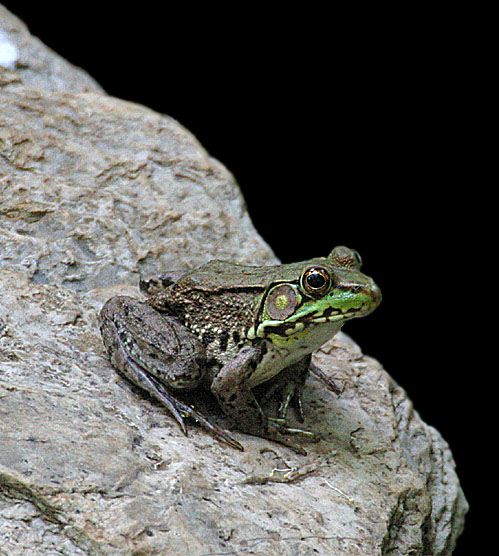
All text & photos © Hilton Pond Center
Comments or questions about this week's installment?
Please send
an E-mail message to INFO.
NOTE: Be sure to scroll down for an account of all birds banded or recaptured
during the week, as well as some other interesting nature notes.
"This Week at Hilton Pond" is written & photographed
by Bill Hilton Jr., executive
director of
Hilton Pond Center for Piedmont Natural History. |
On Goldfish Pond
These colorful fish are an easy-to-care-for addition to any water garden
by Steven A. Frowine
Goldfish have long been revered in Asia, where the Chinese refer to these colorful and graceful fish as "butterflies of
the water." Under many dynasties, they were raised in special ceramic pots for the enjoyment of the emperors. Goldfish are
still commonly depicted in many forms of Asian art, from jewelry to scrolls to ornamental glass eggs.
Today, many gardeners in North America are incorporating goldfish into water gardens. Whether placed in a small in-ground
pond or in an aboveground pool, goldfish are a colorful, low-maintenance, and rewarding addition to any water garden. 
Types of Goldfish
There are many different types of goldfish, from those with fan, fringe, or veil tails, to ones with exotic flowing fins
or hoodlike head growths. Although all the goldfish types can be displayed in a water garden, some varieties are hardier than
others, making them a better choice if you plan to overwinter them outdoors in a cold climate.
The three types that I have found to be the easiest to care for are the Comet, Ryukin, and Shubunkin.
The Comet is the only type of goldfish credited with being developed in the United States. This quick-moving narrow-bodied
fish is most commonly orange or white with a red head. It is named for its tail, which is long and trailing like that of a
comet. It is extremely hardy. This fish is the kind most often seen in fish bowls.
Ryukins are most popular in Japan and China. These round-bodied fish are usually red-orange or red and white, and display
a butterfly-like double tail best viewed when looking down at them as you would in a water garden.
Shubunkins, much admired by British water gardeners, are starting to become better known in North America. Preferred kinds
are calico-colored blue, orange, and white. Like the Comet, Shubunkins are hardy, narrow-bodied fish, although their tails
are shorter.
Goldfish versus Koi
Although both goldfish and koi are related, they are not the same. A couple of key differences make goldfish a much better
choice for a home water garden. Koi grow much larger than goldfish (18 to 24 inches compared with 8 to 10 inches). More importantly
from a water gardener's point of view, koi are voracious plant eaters. Goldfish will nibble at some plants but don't do nearly
as much damage as koi.
Also, koi are best raised in pools with specially designed filtration systems. Such elaborate (and often expensive) systems
are not necessary with goldfish unless you want a large number of them in your pool or water garden. The only piece of equipment
necessary for goldfish is an airstone or small water pump to aerate or circulate the water in hot weather. When temperatures
exceed 75 o F, goldfish can become stressed by the water's low oxygen content.
Another advantage is that fine goldfish are available at garden centers, water gardening specialists, and aquarium stores
for a fraction of the price of koi. Quality goldfish cost between $5 and $50, on average, depending on their type and size;
koi can cost 10 to 100 times that.
Keeping Goldfish Healthy
Most goldfish are naturally hardy and require only a few conditions to keep them in good health. One of the most common
problems arises from adding too many fish to a pool. The result is that fish waste pollutes the water, which becomes the perfect
habitat for green algae to form. Green algae grow suspended in the water, turning it murky green and making it difficult to
see the fish. Excessive algae can kill fish. If the algae suddenly die or are killed with chemicals, the decaying plants will
use more oxygen, and as a consequence, the fish will suffocate.
At a maximum, add only one fish for every 30 gallons of water; fewer are even better. If your pool or pond has no filtration
or aeration, reduce the number still further. Also the larger the surface area of the pool or pond, the more oxygen there
will be in the water.
The best time to add goldfish to a pool or pond is in early spring after the water temperature has reached 60 o
F. The water should contain no chlorine or ammonia. Many municipal water companies add chloramine (a combination of these
chemicals), which is very toxic to fish. To be safe, you can add a water conditioner such as Amquel, available from aquarium
stores, that neutralizes both of these chemicals.
Plants are critical elements in a water garden and are appreciated as much by the fish as by the gardener. They provide
protective cover for the fish and absorb nutrients in the water, substantially reducing green algae blooms. Goldfish are compatible
with most plants. I've planted cannas, water lettuce, nymphaeas, sedges, and waterlilies in my water gardens. As long as the
fish populations aren't too high, you should not experience noticeable plant damage.
Overfeeding is the most common cause of death or decline among goldfish. If your pool is well planted, it is not necessary
to feed the fish at all except, perhaps, when you first add them; they will have plenty to eat with the existing populations
of algae, mosquito larvae, and other water insects. However, feeding the fish brings them to the surface so you can better
enjoy their bright colors.
If you choose to feed your goldfish, use a commercial pellet food such as Hikari or Nippon, giving them only as much as
they can consume within 5 minutes. If you give them too much, the extra food pollutes the water and ultimately kills the fish.
Replacing 10 percent or so of the water in your pool with neutralized tap water every few weeks is a simple yet effective
way to protect against any accumulation of pollutants from fish waste or overfeeding. Goldfish eat very little when the water
is cold, as in spring and fall, so take care not to feed them when temperatures in your area dip to 50 o F.
Goldfish can be kept outdoors for most of the year. I keep mine in two 4- by 8-foot, 3-foot-deep aboveground pools, which
I constructed. These pools, lined with PVC, which lasts for 10 to 20 years, are easy to maintain. Because the pools are raised,
you can sit on the edge to observe the fish up close. Keeping your fish in a small pond is another option, though a less appealing
one when it comes to protecting them from predators.
The most common goldfish predators are herons, raccoons, and cats. All of these animals will wade into water to stalk the
fish. The most effective means of guarding against these predators is to use an aboveground pool with straight, deep sides
so they can't wade in. The fish will be able to quickly swim to the bottom to escape any predator able to perch on the edge.
Another option is to cover the pool or pond with netting at night.
Overwintering
For many gardeners, overwintering fish creates a great deal of anxiety, but it is really quite straightforward. You can
choose one of two methods. One is to leave the fish outdoors if you have an in-ground pool or pond. Goldfish are naturally
cold-water fish, and as long as the pool or pond does not freeze solid, the fish will do fine. The main concern is that if
ice freezes across the entire surface of the pool, noxious gasses resulting from decomposing leaves and other organic matter
in the water will have no way to escape and will be lethal to the fish.
The necessary depth of the unfrozen section varies with the severity of your winters, but for most cold-weather areas ( USDA Hardiness Zones 4 through 6), a depth of 3 to 4 feet in part of the pool is usually sufficient. As a safety precaution, you can add a floating
cattle water trough heater, which has a built in thermostat, to keep at least a section of the pool from freezing solid.
You can also bring goldfish indoors in fall when the weather turns cold, and store them in an aquarium or a child's wading
pool. These small pools come in fiberglass or plastic. If you use the latter, treat it first because plastic residue can be
toxic to fish. To treat a pool, fill it with water and add 1 tablespoon of salt per gallon of water. Let it sit for a couple
of days; then wash it out and add fresh water. Also, treat tap water with a conditioner. The pH level of your household water
should be the same as that of the outdoor water. If the difference in levels is drastic, the shock can kill the fish.
The easiest way to capture fish for transport is to drain three-fourths of the water from the outdoor water garden. With
the fish in a more concentrated area, it's easy to collect them with a small net. Place them in a bucket of water. Float this
bucket in the indoor aquarium or pool, and let the fish make the move into their indoor home.
Steven Frowine is a horticulturist and an expert goldfish hobbyist.
Photography by Digital Imagery copyright 2001 PhotoDisc,
Inc.
 Courtesy of the National Gardening Association Courtesy of the National Gardening Association
|

